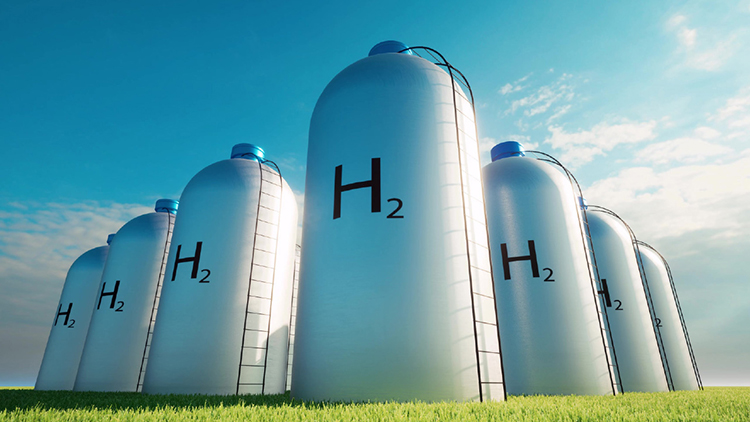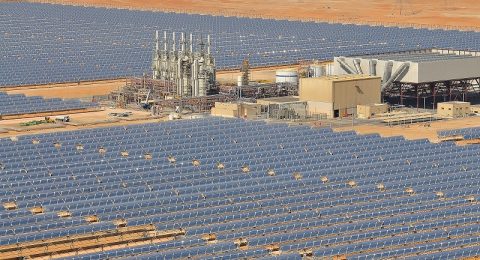As the world strives toward a more sustainable energy future, hydrogen demand, as an energy carrier, is on the rise. This is because when it burns or reacts with air in a fuel cell, it produces water vapor as the only byproduct, emitting no greenhouse gases or pollutants.
Hydrogen produced worldwide reached approximately 95 million metric tons by 2021, 47% of the global hydrogen production is from natural gas, 27% from coal (primarily in China), 22% from oil (as a by-product) and only around 4% from electrolysis.
Herein, natural gas is a bridge fuel in the transition to cleaner energies. That is what scientists from the Skolkovo Institute of Science and Technology in Moscow found as they explored – for the first time – a more sustainable technology for green hydrogen production from natural gas.
Why natural gas?
Natural gas is considered a cleaner fuel than coal. Though it still emits carbon dioxide when burned. Accordingly, some countries including Egypt are implementing carbon capture and storage (CCS) projects to eliminate the emissions and pollutants that come with steam methane reforming process (SMR) process to turn natural gas into clean hydrogen.
Another important reason for utilizing natural gas in the first place is that nuclear or renewable resources, that produce green hydrogen, are much more expensive than fossil fuels.
According to the US Department of Energy (DOE), the cost of hydrogen production from natural gas via SMR process ranges from $1.43/kg to $2.27/kg along with applying CCS. Notably, the cost depends on the delivered natural gas price and differs from country to country.
On the other hand, the cost of hydrogen production from electrolysis at a centralized station is estimated at $5/kg to $6/kg with electricity from nuclear or wind resources.
Thereby, hydrogen from zero-carbon electricity (nuclear or wind) is 2.5-4 times more costly than hydrogen from carbon-neutral or net-negative carbon fossil resources.
But what if there is an innovative approach that could combine both factors, affordability and sustainability?
A Promising Future for Hydrogen Production
Skoltech researchers have explored the conversion of methane into hydrogen in the gas reservoir, rich with hydrocarbons, with zero oil saturation via steam methane reforming initiated by in situ gas combustion without releasing greenhouse gases into the atmosphere.
The outcome reveals a range of variations, each yielding different concentrations of hydrogen produced depending on these adjustable parameters. They found incredible potential for underground hydrogen generation in natural gas reservoirs.
“All the stages of the process are based on well-established technologies that have not previously been adapted for hydrogen production from real gas reservoirs,” said Elena Mukhina, PhD, a senior research scientist at Skoltech Petroleum and the leader of the RSF-supported project.
“We have demonstrated that our approach can help convert hydrocarbons into ‘green’ fuels in the field environment with an efficiency of up to 45%. In the future, we plan to test our method in real gas fields,” Mukhina added.
Laboratory Experiment
Researchers tested the process in lab reactors that simulated a real gas reservoir environment. They placed crushed rock in the reactor and then pumped in methane, the main component of natural gas, along with steam and a catalyst, and then oxygen. The pressure inside the reactor was maintained at a level typical of gas reservoirs, eighty times higher than atmospheric pressure.
As the experiment progressed, the team analyzed the composition of the gases in the reactor to assess the efficiency of the methane conversion into hydrogen. It turned out that most of the hydrogen, 45% of the total gas volume, was formed at 800° C with large amounts of steam injected into the reactor.
In the experimental model, different rock porous media were utilized and the process parameters such as temperature and the steam-to-methane ratio were varied.
For example, to make the reaction as efficient as possible, steam should be four times more than natural gas. Moreover, the researchers chose the 800° C temperature because it is easily achieved in natural gas combustion and does not need to be artificially maintained.
The hydrogen yields also depended on the composition of the rock. In experiments with porous alumina, the hydrogen yield reached 55% i.e. natural rock contains other, more active minerals that can react with the components of the gas mixture and affect the hydrogen yield.
The process details
The process begins with the injection of steam into the well along with a catalyst that will later help separate hydrogen from the natural gas components.
Then, air or pure oxygen is pumped in to ignite the gas directly in the reservoir. Assisted by steam and catalyst, the natural gas burns and is converted into a mixture of carbon monoxide and hydrogen.
The carbon dioxide formed from the carbon monoxide remains in the reservoir and does not contribute to the greenhouse effect.
At the final stage, hydrogen is extracted from the well through a membrane that blocks other combustion products, leaving the carbon monoxide and carbon dioxide trapped underground.
Notably, the study supported by a Russian Science Foundation (RSF) grant was published on January 15, 2024.
This innovative technology developed by researchers at the Skolkovo Institute of Science and Technology offers a promising solution for generating ‘green’ hydrogen from natural gas. As the research progresses to real-world testing, it holds the potential to contribute to a cleaner and more sustainable energy future.








